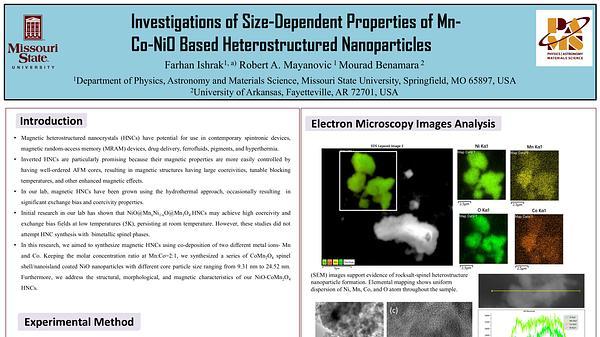Would you like to see your presentation here, made available to a global audience of researchers?
Add your own presentation or have us affordably record your next conference.
Bimagnetic nanoparticles show promise for applications in energy efficient magnetic storage media and magnetic device applications. The magnetic properties, including the exchange bias of nanostructured materials can be tuned by variation of the size, composition, and morphology of the core vs overlayer of the nanoparticles (NPs). The purpose of this study is to investigate the optimal synthesis routes, structure and magnetic properties of novel CoO/NiFe2O4 heterostructured nanocrystals (HNCs). In this work, we aim to examine how the size impacts the exchange bias, coercivity and other magnetic properties of the CoO/NiFe2O4 HNCs. The nanoparticles with sizes ranging from 10 nm to 24 nm were formed by the synthesis of an antiferromagnetic (AFM) CoO core and deposition of a ferrimagnetic (FiM) NiFe2O4 overlayer. A highly crystalline magnetic phase is more likely to occur when the morphology of the core-overgrowth is present, which enhances the coupling at the AFM-FiM interface. The CoO core NPs are prepared using thermal decomposition of Co(OH)2 at 600 °C for 2 hours in a pure argon atmosphere, whereas the HNCs are obtained first using thermal evaporation followed by hydrothermal synthesis. The structural and morphological characterization made using X-ray diffraction (XRD), X-ray photoelectron spectroscopy (XPS) and scanning electron microscopy (SEM) techniques verify that the HNCs are comprised of a CoO core and a NiFe2O4 overgrowth phase. Rietveld refinement of the XRD data shows that the CoO core has the rocksalt (Fd3(bar)m) crystal structure and the NiFe2O4 overgrowth has the spinel (C12/m1) crystal structure. SEM-EDS data indicates the presence and uniform distribution of Co, Ni, and Fe in the HNCs. XPS analysis of the O 1s, Co 2p, Ni 2p, and Fe 2p regions shows that both the core and overgrowth phases are well-structured. The results from PPMS magnetization measurements and high-resolution transmission electron microscopy (HR-TEM) of the CoO/NiFe2O4 HNCs will be discussed.
